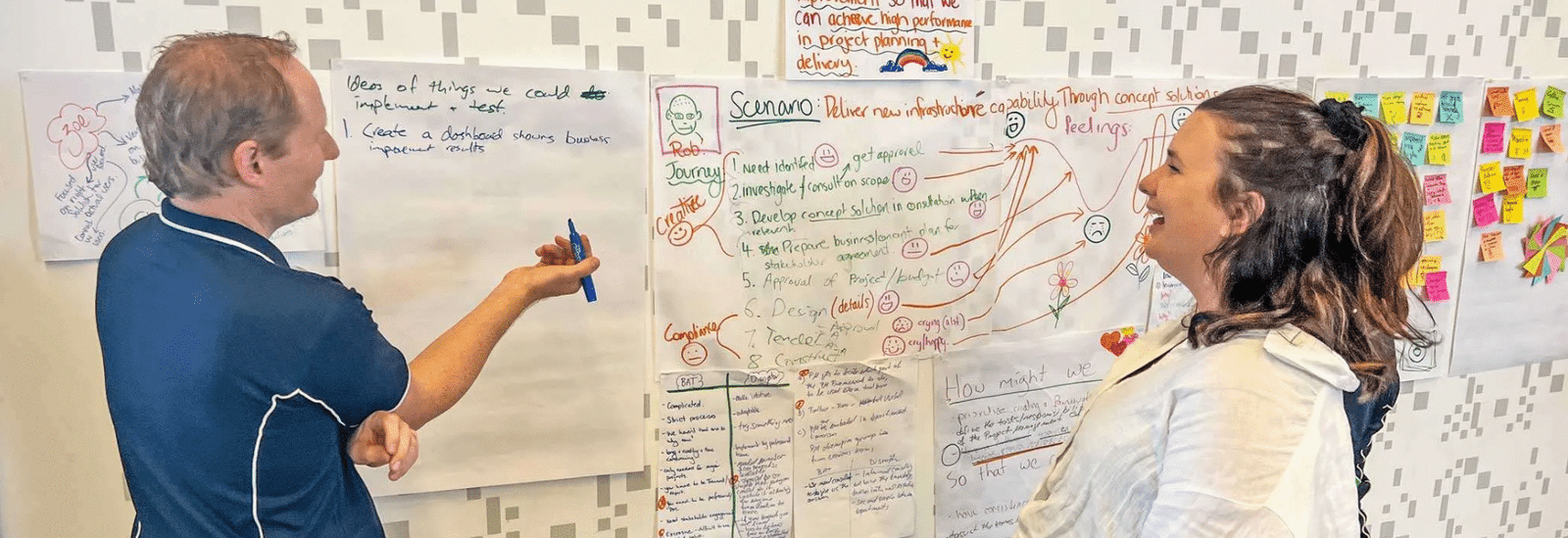
Every team strives to solve challenges more effectively—and a Design Thinking Workshop offers a hands-on way to do exactly that. It creates an environment where empathy, visual thinking, and quick iteration come together to spark fresh ideas and actionable solutions.
A Human-Centered, Visual Approach
What sets this approach apart is its emphasis on seeing the challenge through the eyes of those affected and making ideas tangible. Participants don’t just talk about problems—they sketch, map, prototype, and test concepts in real time. This visual-first method builds clarity and momentum, encouraging continuous exploration and improvement.
By turning abstract thoughts into visible forms—like sketches, storyboards, or low-fidelity models—teams engage more deeply, connect ideas, and learn faster. This playful, iterative approach drives better understanding and alignment within the group.
Core Stages of the Workshop
A structured—but flexible—process guides participants through key stages. Typical phases include:
Empathy and Definition
Participants begin by diving into user experiences—through discussions, observations, or empathy mapping—to uncover real motivations and frustrations. From these insights, the group crafts a focused problem statement as a guiding focus.
Ideation
Once the problem is clear, teams brainstorm widely—using techniques such as “how might we” prompts—to explore a diverse range of ideas. This phase welcomes creativity and encourages bold thinking.
Prototyping
Rather than waiting for polished solutions, participants quickly build simple representations—sketches, paper models, or storyboards—to visualize ideas and make them tangible.
Testing and Iteration
Prototypes are shared with peers or potential users for immediate feedback. These insights guide improvements, helping participants iteratively refine their ideas toward stronger solutions.
Who Gains from a Design Thinking Workshop?
This method is versatile and impactful across various fields:
- Business teams aiming to revitalize products, services, or internal processes
- Start-ups looking to test ideas quickly and align offerings with user needs
- Educators and facilitators seeking engaging methods to promote creativity
- Leaders and professionals wanting to enhance collaborative problem-solving skills
Because it emphasizes doing and creating rather than just talking, anyone—regardless of background or role—can contribute and benefit.
Creating Lasting Change
Although the immediate impact of the workshop is clear—from new ideas to prototypes—the long-term value is equally powerful:
- Teams embrace a mindset of experimentation and adaptability
- Cross-functional collaboration becomes more fluid and open
- Solutions become more grounded in genuine user needs
- Participants build confidence in rapidly testing and refining ideas
These shifts help teams move faster, learn continuously, and stay aligned with their audience.
Practical Steps to Run Your Own Session
Want to design a meaningful workshop? Consider these essentials:
- Invite diverse participants – varying perspectives drive richer ideation
- Use visual tools from the start – whiteboards, sketchbooks, moodboards, or digital platforms help ideas come alive
- Prototype early and simply – even rough sketches or paper models spark insight and feedback
- Embed feedback loops – test early, learn quickly, and refine ideas through iteration
- Reflect and plan next steps – end with clarity on what’s learned, what works, and what comes next
These elements are the foundation of a productive, dynamic session that extends untethered into the team’s everyday work.
Why This Matters
Traditional problem-solving often gets stuck in long discussions or theoretical models. In contrast, a Design Thinking Workshop shifts energy toward action, empathy, and immediacy. Teams gain awareness of user needs and develop solutions that are grounded, thoughtful, and creative.
Participants walk away not just with ideas, but with practical tools—how to co-create visually, prototype quickly, test meaningfully, and iterate intentionally—skills that become part of how they work long after the session ends.
Conclusion
A Design Thinking Workshop transforms the way teams approach challenges. Through empathy, visual collaboration, prototyping, and continuous feedback, it enables groups to create solutions that truly matter. When teams want to unlock innovation, build user-centered design skills, and catalyze meaningful change, the guidance of Simon Banks offers that spark and structure to turn ideas into real-world impact.

